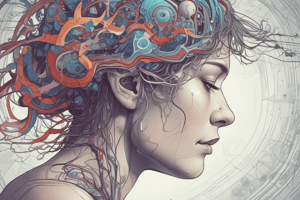Podcast
Questions and Answers
Flashcards
Appraisal
Appraisal
The interpretation of a situation that triggers an emotional response.
Emotions
Emotions
Complex psychological states marked by expressive behaviors, subjective experience, motivational tendencies, and physiological changes.
Discrete Emotions
Discrete Emotions
Basic emotions such as fear or anger are distinct from each other and natural.
Confirmation Bias
Confirmation Bias
Signup and view all the flashcards
Motivated Reasoning
Motivated Reasoning
Signup and view all the flashcards
Metacognitive Reflection
Metacognitive Reflection
Signup and view all the flashcards
Bias Blind Spot
Bias Blind Spot
Signup and view all the flashcards
Self-Serving Bias
Self-Serving Bias
Signup and view all the flashcards
Better-Than-Average Effect
Better-Than-Average Effect
Signup and view all the flashcards
Fundamental Attribution Error
Fundamental Attribution Error
Signup and view all the flashcards
Accountability
Accountability
Signup and view all the flashcards
Motivation
Motivation
Signup and view all the flashcards
Availability Heuristic
Availability Heuristic
Signup and view all the flashcards
Gambler's Fallacy
Gambler's Fallacy
Signup and view all the flashcards
Representativeness Heuristic
Representativeness Heuristic
Signup and view all the flashcards
Type 2 Thinking
Type 2 Thinking
Signup and view all the flashcards
Heuristics
Heuristics
Signup and view all the flashcards
Cognitive Misers
Cognitive Misers
Signup and view all the flashcards
Bounded Rationality
Bounded Rationality
Signup and view all the flashcards
Law of Large Numbers
Law of Large Numbers
Signup and view all the flashcards
Status Quo Bias
Status Quo Bias
Signup and view all the flashcards
Reviewing and Revising
Reviewing and Revising
Signup and view all the flashcards
Language and Thinking
Language and Thinking
Signup and view all the flashcards
Recursive Language
Recursive Language
Signup and view all the flashcards
Symbolic Language
Symbolic Language
Signup and view all the flashcards
Persuasion
Persuasion
Signup and view all the flashcards
Propaganda
Propaganda
Signup and view all the flashcards
Attacking the Person
Attacking the Person
Signup and view all the flashcards
Emotive Language
Emotive Language
Signup and view all the flashcards
Inadequate Comparison
Inadequate Comparison
Signup and view all the flashcards
Weasel Word
Weasel Word
Signup and view all the flashcards
Clarity
Clarity
Signup and view all the flashcards
Study Notes
Appraisal in Emotions
- Emotions often begin with interpreting the situation, a process called appraisal.
Components of Emotions
- Emotions are marked by expressive behaviors, subjective experiences, motivated behaviors, and physiological changes.
Discrete Emotions
- Theories suggesting distinct emotions believe fear and anger are distinguishable, natural, and evident in facial expressions.
Thinking Error: Belief Perseverance
- Refers to maintaining beliefs even when contradicted by evidence, like Dorothy Martin's UFO cult leader example
Thinking Error: Confirmation Bias
- A tendency to favor information confirming existing beliefs.
Thinking Error: Belief Perseverance
- A tendency to maintain beliefs despite contradicting evidence.
Critical Thinking and Biases
- The bias blind spot is the tendency to lack self-awareness of biases.
Better-Than-Average Effect
- Individuals tend to rate themselves favorably compared to others.
Fundamental Attribution Error
- Attributing behavior to internal factors rather than external circumstances, like blaming unemployment on laziness, as in the example of Eliza's thinking error.
Motivated Reasoning
- Individuals interpret events to match desires, like interpreting external factors for job success while blaming personal factors for job failure.
Dual process model
- This model describes two systems of thinking, one fast and intuitive (Type 1), the other slower and more deliberate (Type 2).
Heuristics
- Mental shortcuts in judgment and decision making, often leading to errors; for example, the availability heuristic and representativeness heuristic.
Representativeness Heuristic
- Judging probabilities based on resemblance to existing prototypes, like the mistaken belief that "like goes with like" in judging probabilities.
Availability Heuristic
- Estimating likelihood based on how easily relevant examples come to mind, like the ease to recall tornadoes compared to asthmatic deaths.
Gambler's Fallacy
- Erroneous belief that prior outcomes influence random events, like Jose's belief that after six daughters, they are definitely due for a son.
Overconfidence Effect
- Individuals tend to be overly confident in their judgments and estimations.
Status Quo Bias
- A preference for the existing state of affairs, such as opting into organ donation.
Language and Cognition
- Language is a tool for externalizing and expressing thought processes.
Studying That Suits You
Use AI to generate personalized quizzes and flashcards to suit your learning preferences.
Related Documents
Description
Explore the intricate relationship between emotions and cognitive biases in this quiz. Delve into the concepts of appraisal, discrete emotions, and various thinking errors like confirmation bias and belief perseverance. Enhance your understanding of how emotions influence our thoughts and behaviors.




